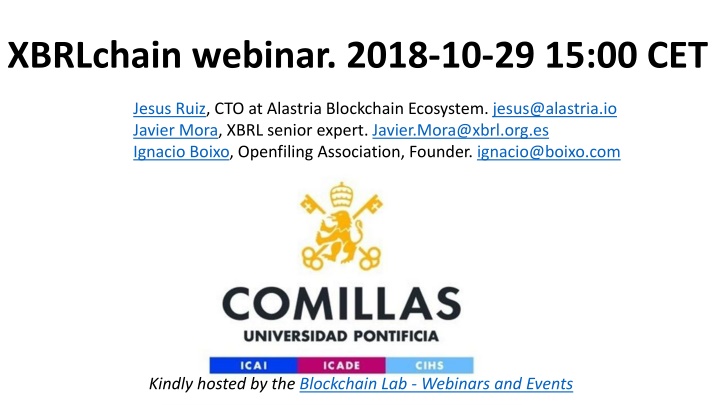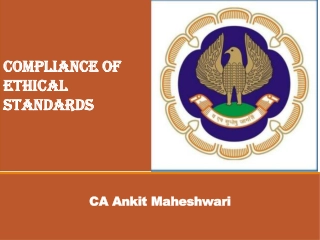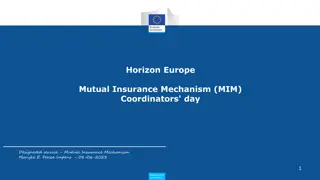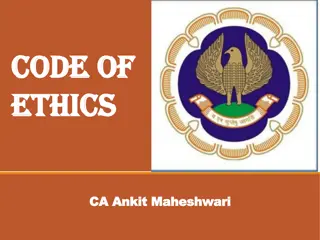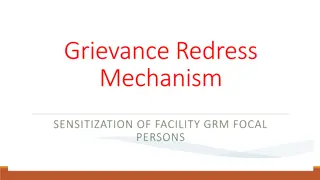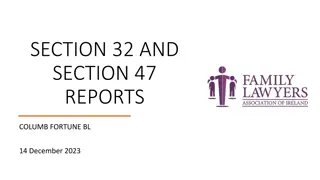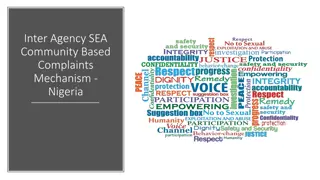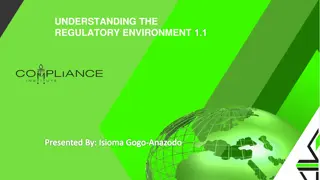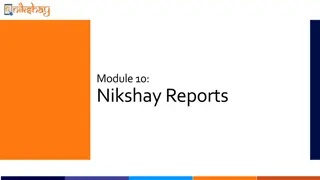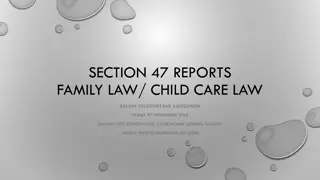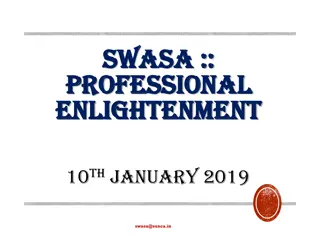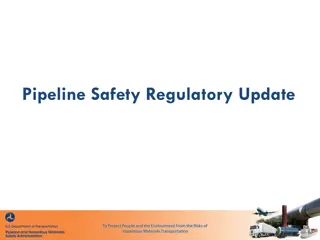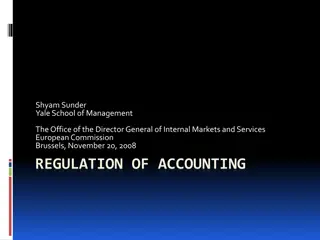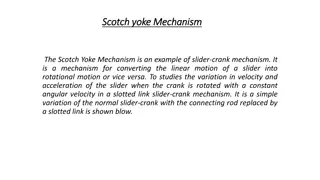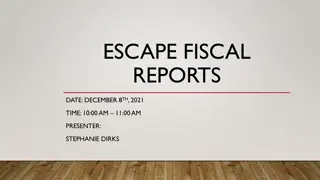Financial Regulatory Reports Publication Mechanism
This content outlines the step-by-step process for publishing financial regulatory reports. It covers how issuers prepare and file reports, auditors sign them, supervisors make them public, and investors access the information. The mechanism ensures integrity and non-repudiation in the distribution of reports.
Download Presentation

Please find below an Image/Link to download the presentation.
The content on the website is provided AS IS for your information and personal use only. It may not be sold, licensed, or shared on other websites without obtaining consent from the author.If you encounter any issues during the download, it is possible that the publisher has removed the file from their server.
You are allowed to download the files provided on this website for personal or commercial use, subject to the condition that they are used lawfully. All files are the property of their respective owners.
The content on the website is provided AS IS for your information and personal use only. It may not be sold, licensed, or shared on other websites without obtaining consent from the author.
E N D
Presentation Transcript
XBRLchain webinar. 2018-10-29 15:00 CET Jesus Ruiz, CTO at Alastria Blockchain Ecosystem. jesus@alastria.io Javier Mora, XBRL senior expert. Javier.Mora@xbrl.org.es Ignacio Boixo, Openfiling Association, Founder. ignacio@boixo.com Kindly hosted by the Blockchain Lab - Webinars and Events
A description of the existing mechanism for publication of Financial Regulatory Reports
Step 1: The Issuer prepares a report. Issuer Unaudited Report
Step 2: The Auditor signs the audited report. Issuer Audited Report Unaudited Report Auditor
Step 3: The Issuer files the report to the Supervisor. Report Issuer Supervisor Audited Report Unaudited Report Auditor
Step 4: The Supervisor made the report public to the market. Report Issuer Supervisor Publication Web Audited Report Unaudited Report Auditor
Step 5: The investor Anna finds and reads the report. Report Issuer Supervisor Publication Web Query? Report Audited Report Unaudited Report Auditor
Step 6: In other Jurisdiction other issuer files another report, to be published and read by Bob. Report Issuer Supervisor Publication Web Query? Report Audited Report Unaudited Report Publication Web Report Auditor Query? Report OAM
Step 7: Carol receives reports from Anna, Bob and others. What about Integrity and Non-repudiation? Report Issuer Supervisor Publication Web Query? Report Reports Supply Chain Audited Report Unaudited Report Publication Web Report Auditor Query? Report OAM Integrity ? Report Non-repudiation ?
Hash 1: The Supervisor notarizes the hash code of the report when it is made public. Supervisor Publication Web Notarize Hash
Hash 2: Other Supervisors/OAMs (and Auditors and Issuers, if allowed) can also notarize reports. Report Issuer Supervisor Publication Web Notarize Hash Audited Report Unaudited Report Notarize Hash Notarize Hash Publication Web Auditor Report OAM
Hash 3: Carol (and Bob, Anna, OAMs and Supervisors) has now a secure check for Integrity and Non-repudiation. Report Issuer Supervisor Publication Web Report Reports Supply Chain Audited Report Unaudited Report Publication Web Report Auditor Check Hash Report OAM Check Report s Hash Integrity, No repudiation Report Check Server
XBRLchain = XBRL secured by Blockchain IssuerA IssuerB IssuerC Notarize: An Identity inserts a Hash ReportA ReportB ReportC HashA HashB HashC HashC SupervisorZ Hash footprint: Biunivocal digest of a report, unrepeatable by nature HashB SupervisorZ HashC HashC AuditorX IssuerC Identities acknowledged in this Blockchain IssuerC AuditorX SupervisorZ HashB AuditorX HashA SupervisorZ Ledger: indelible and public Blockchain pile containing pairs of Hash/Identity
What is the European Financial Transparency Gateway (EFTG)? EU financial rules (Transparency Directive, 2004/109/EC) require companies listed on EU regulated markets to publish certain financial information, such as annual financial reports. This protects investors by helping them make informed investment decisions. However, this reporting is currently done via national databases, which are not connected to each other or a central platform. This makes it more difficult for investors to assess cross-border investment decisions. This is the starting point of the European Financial Transparency Gateway, which links existing national databases through distributed ledger technology. This blockchain-based gateway is a simple and affordable way to share information on listed companies, fostering cross-border investment activity and contributes to a well-functioning Capital Markets Union.
EFTG 1: The Supervisor notarizes the hash code and URL of the report when it is made public. Report Issuer Supervisor Publication Web Report Notarize Hash, URL Reports Supply Chain Audited Report Unaudited Report Publication Web Report Auditor Check Hash Report OAM Report Check Server
EFTG 2: An event is triggered in a Observer Node when the new block containing the notarization is propagated. Report Issuer Supervisor Publication Web Report OK Notarize Reports Supply Chain Audited Report Unaudited Report Event Notarize Publication Web Report Auditor Check Hash Report OAM Report Check Server
EFTG 3: The report is requested to the Supervisor using the Notarized URL Report Issuer Supervisor Publication Web Report URL? Reports Supply Chain Audited Report Unaudited Report Add URL Reports Index Publication Web Report Auditor Check Hash Report OAM Report Check Server
EFTG 4: The report is downloaded for the publication website and included in the Index of Reports Report Issuer Supervisor Publication Web Report Report Reports Supply Chain Audited Report Unaudited Report Reports Index Publication Web Report Auditor Check Hash Report OAM Report Check Server
EFTG 5: Other OAM (or Auditor or Issuer as well) can also notarize other reports when published Report Issuer Supervisor Publication Web Notarize Hash, URL Report Reports Supply Chain Audited Report Unaudited Report Notarize Hash Notarize Hash, URL Report Publication Web Report Auditor Check Hash OAM Report Check Server
EFTG 6: Notarized reports are requested to their respective Publication webs and included in the Index of Reports. Report Issuer Supervisor Publication Web Report Reports Supply Chain Audited Report Unaudited Report Add URL Reports Index Event Notarize Report URL? Publication Web OK Notarize Report Auditor Check Hash Report OAM Report Check Server
EFTG 7: A query to the Financial Gateway gets a list of URLs of the indexed reports matching the criteria. Report Issuer Supervisor Publication Web Report Reports Supply Chain Audited Report Unaudited Report Financial Gateway Query? Reports Index URL list Publication Web Report Auditor Check Hash Report OAM Report Check Server
EFTG 8: David retrieves the selected Reports using the URLs of their respective Publication websites Report Issuer Supervisor Publication Web Report Report Reports Supply Chain Audited Report Unaudited Report Financial Gateway Reports Index Report Publication Web Report Auditor Check Hash Report OAM Report Check Server
EFTG 9: Full overview of functions needed for the European Financial Transparency Gateway. Report Issuer Supervisor Publication Web URL? Notarize Hash, URL Query? Notarize Hash, URL Report OK Notarize Report Report Reports Supply Chain Audited Report Unaudited Report Financial Gateway Add URL Query? Reports Index URL list Event Notarize Report Report URL? Notarize Hash Notarize Hash, URL Report Publication Web Report Auditor Query? Check Hash OAM Check Report s Hash Integrity, No repudiation Report Check Server
Questions? Read more at www.openfiling.info
